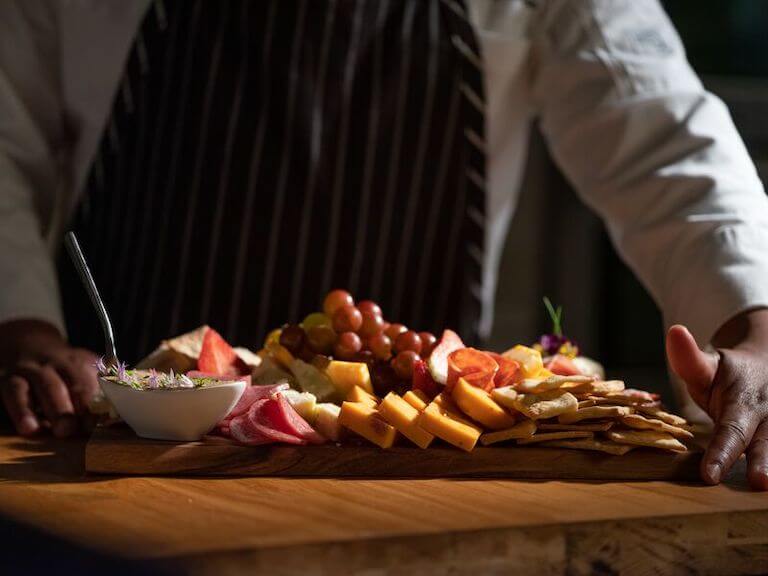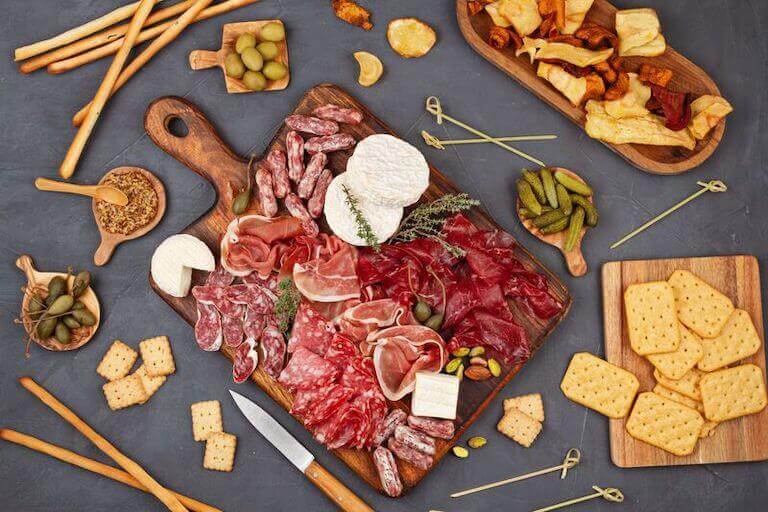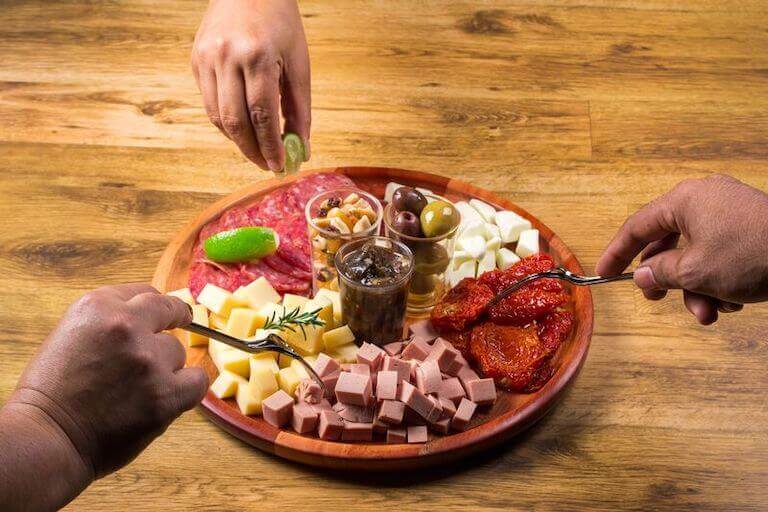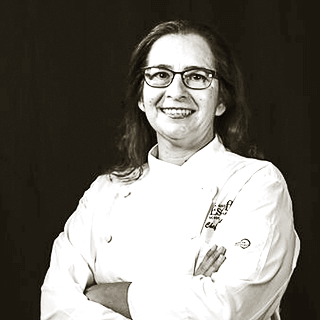As we grow older, we often leave behind childhood wonder and expand our interests in bigger and better ways. Some kids turn in their matchbox cars for adult-size speedsters. Others trade in their tea parties for coffee dates. But our favorite nostalgic glow up is the exchange of Lunchables for charcuterie boards.
The glamorous version of your childhood meat and cheese spread, charcuterie boards seem to be taking the world by storm. But where some might view these aesthetic platters as a trend, we recognize a constant comfort food that’s simply matured alongside us.
There are a few reasons these popular platters have withstood the test of time:
- They are a great dish for budding chefs of all ages since there’s often little to no cooking required.
- They double as a decoration and make a great eye-catching impression at gatherings.
- They are a crowd-pleaser similar to a cheese plate, but with even more variety and options for any taste bud.
In this article, we’ll lay out for you the fundamentals of great charcuterie, so your next gathering can be a resounding success.
Basic Isn’t Bad: The Most Common Charcuterie Board Components
The best part of charcuterie boards is the variety of flavors, textures, and colors they feature. It encourages exploration of new pairings for those who feel a little more daring along with tried and true tastes for those who might be a little more reserved.
If you’re not sure where to start, focus on the basics and choose one of each category:
- Meat (smoked or cured)
- Cheese (mild to sharp) soft to hard
- Crispy (crackers, bread, vegetables)
- Sweet (fresh or dried fruit)
- Crunchy (nuts)
- Briny (olives or pickles)
- Spreads (jams, honey, mustard, mayonnaise)

Simple ingredients create a unique and flavorful assortment when combined together in a charcuterie board.
The Art of Assembling a Charcuterie Board
What charcuterie boards lack in cooking or baking requirements, they make up for in design. A curated spread can immediately catch someone’s eye, but it does require some effort and forethought to execute well.
Prep for Success
Having a great charcuterie board extends beyond just the pieces placed on the platter. You’ll also want to make the experience as easy as possible for party-goers who partake by gathering the following prior to assembly:
- The board
- Containers for sauces
- Serving Utensils (knives, spoons, forks)
- Plates
- Napkins
Within each of these elements lies an extra opportunity to set the tone. Going for a modern vibe? Consider a metal, geometric board. Looking for something more laid back? Use a board that’s a cross section of a tree with raw edges.

Having supplies on hand like the board, knives, and small dishes for sauces can make it easier to assemble a memorable charcuterie board.
Compile the Components
A charcuterie board is really just a combination of different elements placed side-by-side. To make assembly quick and easy, begin by preparing the individual ingredients first. This could include folding the meats, slicing the cheeses, and placing sauces in jars.
Next, consider the flavor pairings that would best complement each other, and group those elements next to each other. This will allow you to place them together on the board and create the best experience for the guest.
Finally, place the items on the board beginning with the large objects or groupings and fill in gaps with smaller items.
Tricks of the Trade
There may not be any clear cut rules for charcuterie boards, but there are certainly some recommendations and guidance you can glean from professionals in the field that will ensure your delivery is top-tier:
- The FDA recommends not leaving boards out for more than 2 hours if there’s cheese, meat, or other ingredients that require refrigeration.
- Some ingredients just aren’t well suited for a charcuterie board. Anything with juice or liquid will make crackers and bread soggy (consider placing it in a sauce dish if your heart is set on keeping it). Additionally, anything overly spicy or sour can overpower anything it’s paired with and not be palate-friendly for a wide range of eaters.
- Charcuterie boards are anything but boring. As you get more comfortable, explore your creative side and form more advanced shapes and designs out of the food to create a more impressive experience.

The ultimate objective of a charcuterie board is to provide an enjoyable, and delicious, experience that will have people coming back for more.
Where Did the Term Charcuterie Originate?
Although America has been a little slow to hop on the bandwagon, charcuterie boards have been around for hundreds of years. According to Britannica, the phrase “charcuterie” derives from 15th century France where a “charcutier” prepared, cooked, and preserved cuts of meat.
Pick Your Palette
If you’ve been agonizing about getting your charcuterie board “just right,” then we have some words that will ease your worried mind: there’s no wrong way to compile a charcuterie board or even a set standard of ingredients. That means you are set to succeed simply by starting.
Yet for others, the lack of rules can feel even more overwhelming than following a detailed recipe with a definitive outcome. Choose to recognize this freedom as an opportunity to let your creativity shine and tap into your own expertise to create great flavor combinations with foods that complement each other well.
Each charcuterie experience is truly one-of-a-kind.
Types of Charcuterie Boards
The options are endless, but here are a few charcuterie board ideas to get your creative culinary juices flowing:
- Meat & Cheese: the traditional take using smoked or cured meats like salami or prosciutto along with any cheese variety.
- Breakfast: the early bird won’t need a worm when presented with mini muffins, waffle strips, tiny pancakes, and an array of dipping syrups.
- Dessert: charcuterie has never tasted sweeter than when featuring a cacophony of cookies, brownies, assorted icings, and sprinkleable toppings of every kind.
- Butter Board: the (literal) bread and butter version includes a base of softened butter topped with jams, nuts, and honey or a more savory combination of herbs.
- Cultural-Focused: travel around the globe with a platter that highlights a specific region and their unique flavors, for example Mexican, Italian, or Asian.
- Holiday Themed: highlight the best bites of a holiday by creatively displaying spooky foods on Halloween or gingerbread houses for Christmas.
Develop Culinary Confidence
Ultimately, charcuterie boards can be as simple or as complex as you choose to make them, but with continual practice and experimentation, you’ll notice your skillset start to improve.
While creating a truly great charcuterie board requires a lot of knowledge regarding flavor pairings and proportions, an education from experts can provide the confidence to pull off charcuterie boards flawlessly each time and for any occasion. Auguste Escoffier School of Culinary Arts can develop your culinary confidence and take you from charcuterie novice to charcuterie connoisseur. Explore all of our culinary arts programs to see if it’s right for you.




